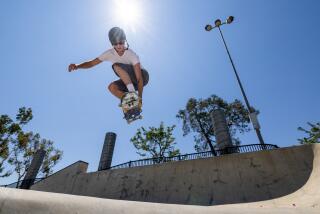In-Line Skating Wins Exercise Points : Health: Running, cycling and swimming have long been considered ways to stay fit. But this new mode of recreation is gaining in popularity.
AMHERST, Mass. — University of Massachusetts senior Deidra Smith likes to call herself “Lab Rat No. 13.”
The environmental science major is one of 39 students who have been either running or skating laps for the past semester as part of research aimed at determining the aerobic value of in-line skating.
“In-line skating has become an extremely popular mode of recreation for the public over the past five years, but there has been very little research on the physiology,” said exercise science professor Patty Freedson, who heads the project.
“Running, cycling and swimming have been considered the exercises one should do to keep cardiovascularly fit,” she said. “But sometimes people find those activities boring, and it is difficult to maintain good compliance. We wanted to study in-line skating, because it is, well, fun.”
She found in an earlier study that skating at 13.5 miles an hour, a typical pace for a recreational skater, burned as many calories as running 7.6 m.p.h.
One other comparative study by researchers at the Henry Ford Hospital in Detroit found that, at recreational speeds, in-line skaters had to expend about 10% more effort than runners to burn the same amount of calories.
“It makes sense,” said Frank Fedel, who headed the hospital study. “A runner is always working, but an in-line skater has that moment of rest during the glide.”
Since September, both groups of UMass students have been going through 40-minute workouts three days a week--the skaters at a rink just off campus and the runners at the university’s old basketball gym. They wear heart monitors and their exercise is regulated so that both runners and skaters get their hearts beating at 85% to 90% of maximum rates.
Researchers recently began measuring and comparing the changes in the students’ bodies, muscle tone, endurance, leg strength and general fitness.
Results of the study, financed with a $70,000 grant from skate manufacturer Rollerblade, won’t be completed for several months. But both runners and skaters say they benefited from the workouts.
“One of the reasons I volunteered was I wanted some exercise,” said Smith, one of the skaters. “Besides, I get a free pair of skates and two credits without having to do a term paper.”
“It was a way to get in shape, plus get to know how these things are done,” said Adam LaBonte, a sophomore exercise science major. LaBonte and the other runners also got a pair of skates and two credits toward their degree.
The Detroit study, conducted last spring, used only in-line skating racers, but had its own unusual features. After being fitted out with a snorkel-like gas mask and 60-liter plastic bag to collect exhaled air for chemical analysis, a headset that gave timed instructions and a portable heart monitor, the skaters went zooming around the concrete concourse of the Pontiac Superdome.
“We got some stares,” said Fedel. “But because it was indoors, there was no wind.”
But even indoors, wind drag becomes a factor in in-line skating physics at racing speeds of 20 m.p.h., just as it does in skiing, cycling and ice skating.
Calorie consumption jumped 50% when skaters boosted their speed from 14 m.p.h.--a point where a typical recreational skater is working moderately hard--to 17 m.p.h. because of the wind, Fedel said.
“At 17 miles an hour, a novice or intermediate skater is working very hard, but at 10 to 14 miles an hour, aerodynamics aren’t a factor,” he said.
Friction also plays a role at lower speeds. Just how much harder an individual skater had to work to burn the same calories as a runner depended in large part on the quality of his or her skates.






